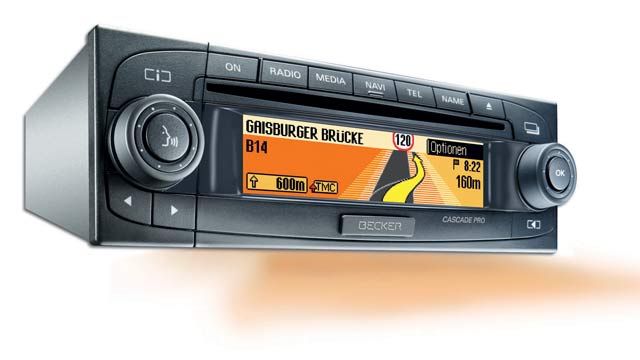Harman Becker Designs and Verifies OFDM Radio Receivers
"A low bit error rate provides an easy way for us to distinguish Harman Becker products from those of our competitors. Model-Based Design with MathWorks tools enabled us to evaluate this key metric in our designs months—if not years—earlier than was previously possible."
Challenge
Solution
Results
- Design verified early in development
- Communication between development teams improved
- Baseband model development accelerated

Engineers at Harman Becker Automotive Systems are developing the next generation of automotive audio and video systems using orthogonal frequency-division multiplexing (OFDM), a multicarrier modulation scheme for wideband digital communications. Their goal is to implement multiple digital broadcast standards like Digital Audio Broadcasting (DAB) and Digital Radio Mondiale (DRM) on a single device.
Harman Becker engineers use MathWorks tools for Model-Based Design to model and simulate receiver baseband algorithms, estimate bit error rate (BER) performance, verify initial designs, and enable teams working in different domains to collaborate. Previously, design verification required more costly and time-consuming approaches, including extensive C programming and hardware prototypes–approaches that uncovered problems late in the design cycle, if at all.
“The bit error rate is the receiver performance measure that distinguishes our products,” explains Axel Westenweller, senior development engineer, signal processing, at Harman Becker. “By modeling, simulating, and verifying our design in Simulink, we were able to get an accurate, rapid assessment of the system's BER, enabling us to make key design decisions very early on.”
Challenge
The engineers needed a golden reference that would enable them to estimate BER performance well before the design would be committed to hardware.
"We need tooling to simulate BER performance as soon as possible in our design process so that we can determine what kinds of errors we must correct in hardware and what kinds we must compensate for in our baseband algorithms," Westenweller notes.
Harman Becker also needed to verify the fixed-point performance of the system using a standardized library of C functions that numerically matched the fixed-point compiler intrinsic instructions optimized for the target DSP.
Solution
Using MATLAB®, Simulink®, and Communications Toolbox™ as their integration and verification environment, Harman Becker engineers modeled, simulated, visualized, and verified baseband implementations of digital broadcasting standards. Simulink simulations enabled them to verify each stage of the design and to quickly understand operational characteristics, including signal constellations and power spectral densities.
The team partitioned the task into multiple segments, including channel encoding and decoding, OFDM modulation and demodulation, the fading propagation channel, and hardware-related RF impairments like thermal noise and phase noise. They used Simulink to develop a floating-point model of the digital baseband layer, which included the Viterbi channel decoder from Communications Toolbox.
The DAB standards require a differential quaternary phase shift keying (DQPSK) symbol mapping, including frequency interleaving. To meet this requirement, Harman Becker engineers created a customized DQPSK block in MATLAB, which they included in their Simulink model as a MATLAB S-function. The team captured real-world digitized intermediate frequency (IF) data produced by an RF front end. To verify the OFDM demodulation and channel decoding, they used this data as input for Simulink simulations, comparing the resulting data with the original, transmitted data.
With Simulink they simulated the influence of phase noise. Bit error rates were analyzed using BERTool in Communications Toolbox. Using the Simulink model as a golden reference, Harman Becker engineers verified the floating-point functionality of their design before replacing Simulink blocks in the model with fixed-point S-function equivalents written in C. The team could then verify the implementation executing on the TI C6000 DSP in bit-true fashion.
The team uses Rician and Rayleigh fading channels from Communications Toolbox to model real-world wireless communication phenomena, including multipath propagation and Doppler shifts.
The RF and digital systems teams are working together to parameterize this model to match real-world performance of the RF front end. A fixed-point implementation of the design is being developed on the target hardware.
Results
Design verified early in development. Simulink enabled Harman Becker engineers to thoroughly verify their design early in the development process, avoiding rework and expensive downstream problems. "Working without MathWorks tools on an earlier, similar project, it took 3 to 4 engineer-years before we could perform a BER test," says Westenweller. "Using MathWorks tools, we reduced that time by at least 75 percent."
Communication between development teams improved. "It is very important to our company to have an executable specification that all engineering departments agree on," says Westenweller. "Our RF team and our digital systems development teams can use MATLAB and Simulink as a common language."
Baseband model development accelerated. "For us, a key advantage of using Simulink and Communications Toolbox is the ability to rapidly build a baseband model using the building blocks provided and add detail as needed," says Westenweller. "Without MathWorks tools, we would spend too much time and effort building these blocks in C instead of exploring and evaluating design options."